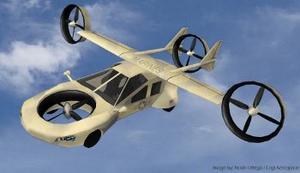Military technologyNew counter-IED approach: flying car
California based company offers a solution to the vexing IED problem: a car flying car; if soldiers find themselves in a tactical situation requiring a quick escape, they can flip a switch and the car just shoots up in the air; in April DARPA invited engineers to dream up a flying car — for the initial design of which it allocated $54 million — to give the military an “unprecedented capability to avoid traditional and asymmetrical threats while avoiding road obstructions” through vertical takeoff and landing

Concept drawing of the Tyrannos // Source: Logi Aerospace
Most of the casualties, dead and injured, the U.S. and other militaries have suffered in Iraq and Afghanistan have been caused by improvised explosive devices (IEDs) hidden on the side of roads. This is likely to be the situation in future theaters. The IED problem is serious enough for the Pentagon to create a well-funded research group dedicated to finding a solution.
Sacramento, California-based Logi AeroSpace offers its own counter-IED solution: Hit a button on the back of a steering wheel and vertically lift your vehicle off the road, into the sky, and out of the range of the road-side bomb.
The company’s Tyrannos is a four-wheeled car that relies on four small rotary wings for its vertical lift. Spencer Ackerman writes that Larry Ortega, the Nebraska company’s CEO and a retired Air Force major, does not have a prototype yet, but that he has something he calls “shrouded propeller” technology. His partner and chief engineer, Robert Bulaga of Folsom, California-based Trek Aerospace — part owner of Logi, a company that Bulaga and Ortega started just for the Tyrannos project — “invented a way to twist a wing into a circle around propellers,” he says, allowing more lift capability using “half the propeller area of anyone else.”
Ortega told Ackerman that that how exactly they have shaped the shrouds around the propellers is a “trade secret,” but that it sounds like a ducted fan one would see in a hovercraft.
Ortega says that the purpose is not to build a Fantasti-car, but rather to create something practical. Ortega aims to build the Tyrannos “the size of an SUV” so it can seat four and fit in your garage (when you take the wings and the tailboom off).
For Ortgea it also means that if you can drive a car, you can fly one. “We want to eliminate all that training” for pilots, Ortega says. According to the company’s specs, a driver will see a simulated “highway” on the windshield, complete with virtual road simulations indicating direction.
Press an “Up” paddle on the back of the wheel and the Tyrannos “literally starts climbing in the air,” Ortega says. “You see that road” — simulated on the windshield — “start to lift up” and so you follow it, using the pedals and the steering wheel, as if in an arcade racing game, to stay on course.
Owners of the flying car will not be flying very high: 200 to 500 feet, optimally — “maybe 1,000,” Ortega says.
It is a car designed to weigh about 1,800 pounds with a payload of 1,100 extra pounds so it can take off from a rest position. Run it down an 180-foot track before it takes off, and you can add about 750 more pounds on board. That should be enough for four soldiers or marines and their gear. Accordingly, its lightness means it is going to have survivability issues.
If soldiers find themselves in a tactical situation — some kind of combat scenario — requiring a quick escape, they can flip a switch, and the car just shoots up in the air. They will dodge the IED that is trying to disable the vehicle.
Ackerman writes that there will be a need for a member of the unit to fire his or her rifle at the bad guys, because the Tyrannos is not going to have a gun mounted on it. Ortega intends to build it to be “survivable for bullets,” with “as much protection as Army helmets.”
Ortega has to convince DARPA, the Pentagon’s research division. In April DARPA put out a request for proposals for what it called its Transformer (TX) program, inviting engineers to dream up a flying car again (“DARPA unveils details of Transformer TX flying car,” 14 April 2010 HSNW; and “The first true flying car: DARPA’s Transformer TX,” 27 May 2009
Logi AeroSpace pitched the Tyrannos about a month ago. If DARPA thinks the technology checks out and the company’s bid makes sense, then the agency will release the cash to let Logi AeroSpace manufacture a prototype.
Ortega told Ackerman that he estimates it will take up to two years to build the mostly electric car and its navigation system (Ackerman notes that realistically, pending some due diligence, trade studies and analyses that are part of the contracting process, it is about four years away).
If it works, the civilian applications are obvious. “You finally get your flying cars,” Ortega forecasts. “And I mean truly flying cars. I don’t mean cars you have to drive to the airport to take off.”
